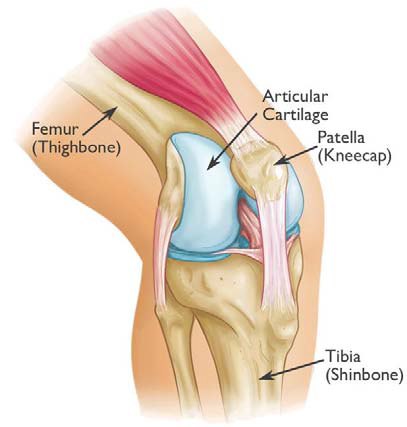
The patella covers and protects the knee
A patellar fracture is a break in the patella, or kneecap, the small bone that sits at the front of your knee. Because the patella acts as a shield for your knee joint, it is more likely to break if you fall directly onto your knee or hit it against the dashboard in a car accident. A patellar fracture is a serious injury that can make it difficult or even impossible to straighten your knee or walk.
Some simple patellar fractures can be treated by wearing a cast or splint until the bone heals. In most patellar fractures, however, the pieces of bone move out of place when the injury occurs. For these more complicated fractures, surgery is needed to repair the kneecap.
What is the anatomy of the patella?
The patella is a small bone located in front of the knee joint — where the thighbone (femur) and shinbone (tibia) meet. It protects the knee and connects the muscles in the front of the thigh to the tibia.
The ends of the femur and the undersides of the patella are covered with a smooth substance called articular cartilage. This cartilage helps the bones glide easily along each other as you move your knee.
What causes a patellar fracture?
Patellar fractures are most often caused by:
- Falling directly onto the knee
- Receiving a sharp blow to the knee, such as might occur during a head-on vehicle collision if your kneecap is driven into the dashboard
The patella can also be fractured indirectly. For example, a sudden contraction of the quadriceps muscle in the knee can pull apart the patella.
What are the symptoms of patellar fracture?
The most common symptoms of a patellar fracture are pain and swelling in the front of the knee. Other symptoms may include:
- Bruising
- Inability to straighten the knee or keep it extended in a straight leg raise
- Inability to walk
What are the different types of patellar fractures?
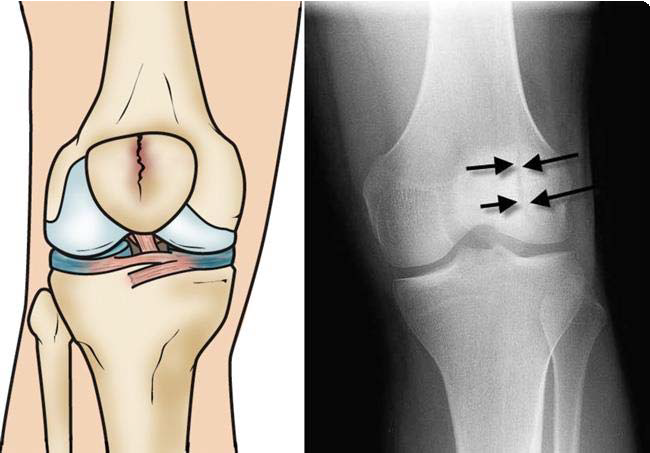
Illustration and x-ray show a vertical, stable fracture of the patella.
In this type of fracture the pieces of bone may remain in contact with each other or be separated by just a millimeter or two. In a stable fracture, the bones usually stay in place during healing.
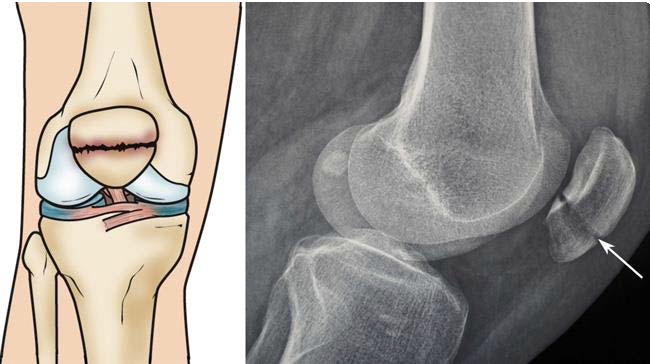
Illustration and x-ray show a front (left) and side (right) view of a two-part fracture across the patella (transverse fracture) with slight displacement between the broken pieces of bone.
In a displaced fracture, the broken ends of the bone are separated and do not line up correctly. The normally smooth joint surface may have also moved. This type of fracture often requires surgery to put the pieces of bone back together.
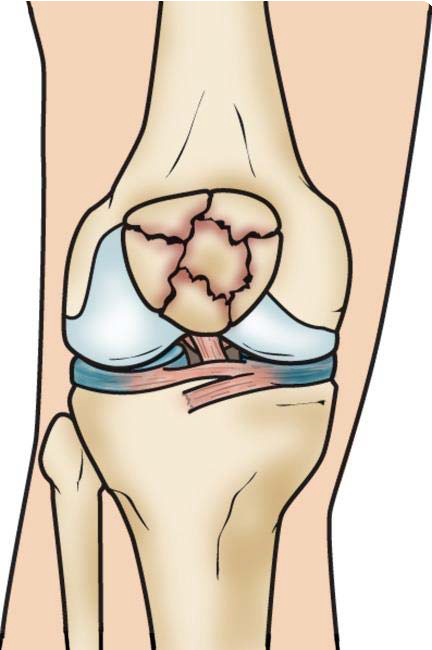
A comminuted fracture
In this type of fracture, the bone shatters into three or more pieces. Depending on the specific pattern of the fracture, a comminuted fracture may be either stable or unstable.
Open fracture. In an open fracture, the bone breaks in such a way that bone fragments stick out through the skin or a wound penetrates down to the bone. An open fracture often involves damage to the surrounding soft tissues and may take a longer time to heal. Open fractures are particularly serious because, once the skin is broken, there is a higher risk for infection in both the wound and the bone. Immediate treatment is required to prevent infection.
How is a patellar fracture diagnosed?
After discussing your symptoms and medical history, your doctor will examine your knee. The edges of the fracture can often be felt through the skin, particularly if the fracture is displaced.
During the exam, your doctor will check for hemarthrosis. In this condition, blood from the fractured bone ends collects inside the joint space, causing painful swelling. If you have a large amount of blood in your knee, your doctor may drain it to help relieve your pain. Your doctor will also order x-rays to help diagnose your fracture.
How is a patellar fracture treated without surgery?
If the pieces of bone are not out of place (displaced), you may not need surgery. Your doctor may apply a cast or splint to keep your knee straight and help prevent motion in your leg. This will keep the broken ends of bone in proper position while they heal.
Depending upon your specific fracture, you may be allowed to bear weight on your leg while wearing a cast or brace. With some fractures, however, weight bearing is not allowed for 6 to 8 weeks. Your doctor will talk with you about restrictions on weight bearing.
How is a patellar fracture treated with surgery?
The type of procedure performed depends on the type of fracture you have. Before the surgery, your doctor will discuss your procedure with you, as well as any potential complications.
Transverse Fracture
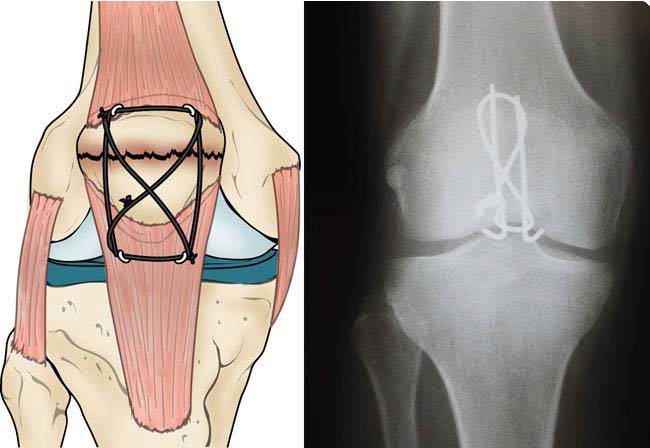
In this illustration and x-ray, a figure-of- eight tension band has been used to hold a transverse fracture together.
These two-part fractures are most often fixed in place using screws or pins and wires and a "figure-of-eight" configuration tension band. The figure-of-eight band presses the two pieces together. This procedure is best for treating fractures that are located near the center of the patella. Fracture pieces at the ends of the kneecap are too small for this procedure. Breaks that are in many pieces can be over compressed by the tension band.
Another approach to a transverse fracture is to secure the bones using small screws or small screws and small plates.
Comminuted fracture.
In some fractures, the top or, more likely, the bottom of the patella is broken into several small pieces. This type of fracture occurs when the kneecap is first pulled apart from the injury, and is then crushed when the patient falls on it.
Because the bone fragments are too small to be fixed back into place, your doctor will remove them. He or she will then attach the loose patellar tendon back to the remaining patellar bone.
If the kneecap is broken in many pieces at its center and the pieces are separated, your doctor may use a combination of wires and screws to fix it. Removing small portions of the kneecap that cannot be reconstructed may also have good results. Complete removal of the kneecap is a last resort in treating a comminuted fracture.
What is recovery like after a patellar fracture?
Rehabilitation
Whether your treatment is surgical or nonsurgical, rehabilitation will play a vital role in getting you back to your daily activities. Because treatment for a patellar fracture can sometimes require keeping your leg in a cast so that you are unable to move it for a long period of time, your knee may become stiff and your thigh muscles may become weak.
During rehabilitation, your doctor or a physical therapist will provide you with specific exercises to help:
- Improve range of motion in your knee
- Strengthen your leg muscles
- Decrease stiffness
Weight Bearing
Your doctor will tell you when you can begin to bear weight on your leg. Initial weight-bearing exercise is usually limited to gently touching your toe to the floor. As your injury heals and your muscles strengthen, you will gradually be able to put more weight on your leg.
How long does it take to recover from a patellar fracture?
This will depend upon a number of factors, including:
- The severity of your injury
- Whether your treatment was surgical or nonsurgical
- The time needed for rehabilitation
Most patients will be able to return to their normal activities within 3 to 6 months. For patients with severe fractures recovery may take longer
Your doctor may suggest some lifestyle changes to help protect your knee and prevent future problems. This may include avoiding activities that involve repetitive deep knee bending or squatting. Climbing stairs or ladders should be avoided, as well.
The information presented on this page is for informational purposes only. Please consult your physician for guidance and treatment options.
